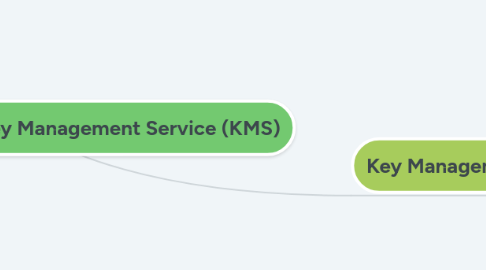
1. Key Management Service
1.1. With the Master Key, you can generate Data Keys, which in turn are used for the encryption
1.2. Data Keys are used for encrypting data. A Data Key is in plain text, so needs to be secured
1.3. Disable, delete and manage the lifecycle of the keys
1.4. Master Keys can encrypt max 4KB of data
1.5. Master Keys can also be used for encryption of data such as passwords
1.6. Types of Keys: once created by AWS and keys created by the account owner.
1.6.1. Customer Master Keys (CMK)
1.6.1.1. CMK is a logical representation of a master key
1.6.1.2. Creation Steps
1.6.1.2.1. Create alias and description
1.6.1.2.2. Create a Tag
1.6.1.2.3. Define Key Administrative Permissions: Users who have Admin Privileges for the Key.
1.6.1.2.4. Define User Permissions
1.6.1.2.5. Preview Key Policy
1.6.1.3. Data keys are encryption keys that you can use to encrypt data, including large amounts of data and other data encryption keys
1.6.1.4. Key Material is the underlying algorithm for encryption and decryption. You can create your own Key Material and import and use it for a AWS CMK
1.6.2. AWS Managed CMK
1.6.2.1. AWS managed CMKs are CMKs in your account that are created, managed, and used on your behalf by an AWS service that is integrated with AWS KMS.
1.6.2.2. AWS owned CMKs are not in your AWS account. They are part of a collection of CMKs that AWS owns and manages for use in multiple AWS accounts. AWS services can use AWS owned CMKs to protect your data.
1.6.2.3. No actions can be done on these keys and are used internally by AWS Services.
1.6.3. AWS Owned CMK
1.7. Encrypting and Decrypting
1.7.1. AWS CLI (Command Line Interface) can be used
1.7.2. AWS Encryption SDK is a client-side encryption library that integrates with KMS to make it easier to implement encryption best practices in your applications
1.8. Key Policies
1.8.1. If a new feature is added to KMS, it is automatically added to the default Key Policy. For older keys this has to be done manually
1.8.2. Default policies are created, providing admin permissions to the root user
1.9. Audit and Logging
1.9.1. Cloudtrail logs can be used to check the usage of the keys. This is not available in all regions.
1.10. KMS & S3 Buckets
1.10.1. S3 Encryption Process
1.10.1.1. S3 request plaintext and encrypted Data Key from KMS
1.10.1.2. S3 encrypts te object with the plaintext data key and deletes the plaintext key
1.10.1.3. The encrypted Data Key is stored with the encrypted data
1.10.2. S3 Decryption Process
1.10.2.1. S3 sends encrypted Data Key to KMS
1.10.2.2. KMS send plaintext key from to S3 based on Customer Master Key
1.10.2.3. S3 decrypts the object with the plaintext Data Key, and deletes it asap
1.10.3. Encryption on bucket level does not encrypt the existing objects in that bucket
1.11. KMS & EBS
1.11.1. By default AWS uses CMK when encrypting EBS vokumes. You can also choose the Key for the encryption
1.11.2. Encryption process uses the encrypted Data Key from the chosen CMK received from the KMS and attach it as metadata to the EBS volume.
1.11.3. Decryption occurs when the EBS volume is attached to the EC2 instance. The encrypted Data Key is sent to KMS and a plaintext Data Key is received and stored in the hypervisor memory to encrypt disc I/O on the disc volume
1.11.4. When the Key is disabled, the current volume will still be able to be decrypted by the EC2 instanced. BUT if the volume is detached from the instance the decryption will not work anymore
1.12. Key Rotation
1.12.1. AWS rotates the backend key and keeps the initial Key ID. Key ID is a pointer to the CMK
1.12.2. When a key is deleted, a schedule for the deletion is created. AWS will delete it between 7 and 30 days. Deletion is irreversible
1.12.3. Disable the Key instead of deleting. You can always re-enable a key
1.13. Key Caching
1.13.1. Key caching can be used within the SDK to reduce costs
1.13.2. By requesting multiple Data Keys, you achieve a higher Security Level
1.14. DynamoDB Encryption at rest
1.14.1. Encryption can only be done when the table is created.
1.14.2. Encryption is also done for the indexes
1.14.3. Metadata from S3 objects is not encrypted. A solution is to store it in a DynamoDB table and encrypt.
1.15. General Notes
1.15.1. KMS is a region-wise service. Keys defined in one region cannot be used in another region
1.15.2. KMS uses FIPS 140-2 validated hardware security modules to generate and store your keys
1.15.3. KMS is integrated with AWS CloudTrail to provide a consolidated record of all key management activities and any attempt to use your keys

